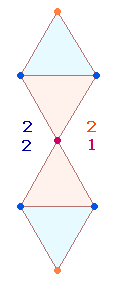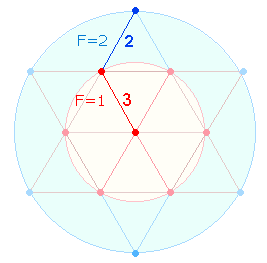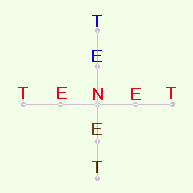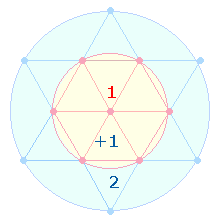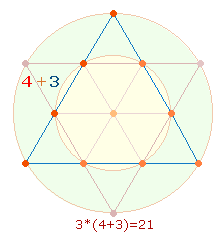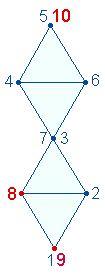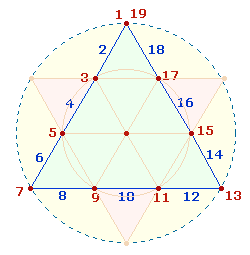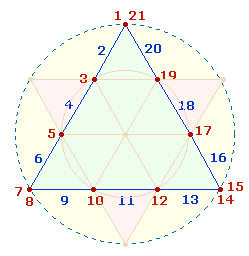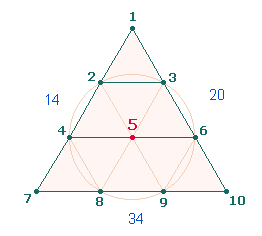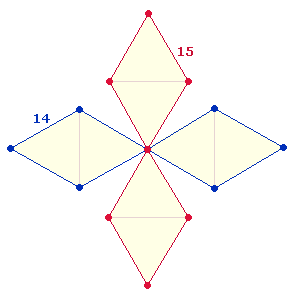back
Alphabets;
factoral values
Shakespeare's
Epitaph
D. VESTA and IESVS – Two sides of One Coin
Part C continues Part B and should be
consulted first.
II. Shakespeare's reference to VESTA and IESUS
III. TAU – The significance of 19 and 21
IV. Further Meaning of 23, 22, ES
E. Gematric
aspects of the 4 Y-Words
I. Values and
Meanings
1. The two names VESTA and IESVS show three obvious parallels: 5 letters, equal word
positions of ES and the equal letters VES/ESV.
The numeric values (NV) and factoral values (FV) of the three letters
are:
|
|
NV |
FV |
FV1 |
FV2 |
|
E |
5 |
5 |
|
|
|
S |
18 |
8 |
|
|
|
V |
20 |
9 |
|
|
|
Sm. |
43 |
22 |
43 |
13 |
|
|
65 |
56 |
||
The numerical sum (NS) 43 may be related to 4+3 points of the double
rhombus:
|
|
The factoral
values (FV1, FV2) of the NS+FS 65 lead to the inverted number 56. As a rhombus consists
of 4 points + 2 triangles and 5 lines = 6+5 elements, the two
inverted numbers represent two rhombi, united in a double rhombus by one single
central point.
Equally, the factoral
sum (FS) 22 stands for two rhombi or a double rhombus. The FV of 22 is 13. The single numbers of
these two figures signify the relation of area size to radial elements: 2
area units (F) of the outer ring correspond to 2 radial elements, 1
area unit (F) to 3 radial elements:
|
|
It's most
remarkable that the NS+FS of Shakespeare's epitaph is 2213, made up of 1242+971. It would not make
sense to ascribe this result as chance, it makes all sense if we assume that is
was the poet's deliberate choice.
The three
equal letters ESV can be understood as ES V – You are the V.
2.
The remaining two pairs of letters, prove to provide
proportional and complementary results, too:
|
|
VESTA |
IESVS |
||||||
|
|
T |
A |
sm. |
FV1/2 |
I |
S |
sm. |
FV1/2 |
|
NV |
19 |
1 |
20 |
9 |
9 |
18 |
27 |
9 |
|
FV |
19 |
1 |
20 |
9 |
6 |
8 |
14 |
9 |
|
sm. |
|
|
40 |
18 |
|
|
41 |
18 |
|
36:81 =
9*(4:9) |
||||||||
The positions of the
two pairs as two-digit numbers are 45 and 15, forming the ratio 15*(3:1).
3.
The perfect complementary quality of the two names becomes
clear if their full values are compared:
|
|
NV |
FV |
Sm. |
FV1 |
FV2 |
Sm. |
total |
|
VESTA |
63 |
42 |
105 |
13 |
12 |
25 |
130 |
|
IESVS |
70 |
36 |
106 |
14 |
10 |
24 |
130 |
|
Sm. |
133 |
78 |
211 |
|
|
49 |
260 |
|
63:70 =
7*( |
|||||||
The NS 133
points to the arrangement of points in the double rhombus:
|
|
The factors 7*19 again signify the
number of circular areas (F) and radial elements:
|
|
The common divisors 7 and 6 of the two ratios can
be attributed to the 7 points of the hexagon and the 6 points of the
extension.
The ratio numbers 9+10 = 19 and 7+6 = 13 are related
chiastically to each other: 9 has the FV 6 and 10 the FV 7. The equivalent
letters are TN forming the central letters of the TENET Cross of the
|
|
The NS+FS 211 is a prime number. Its single numbers indicate the ratio 3:1 of the two concentric circles of the tetraktysstar:
|
|
211 is also the inversion
of 112, the NV of CHRISTUS.
The FV1/2 sums 25+24
= 49
refers to 25 elements of the hexagon and 24 elements of the extension part.
The equality of the two
names can be seen in the total result of 130 for each. It
corresponds to the NS of SATOR (69) TENET (61) – The
Creator Holds
to be read twice.
II. Shakespeare's reference to VESTA and IESUS
1. Always on condition
that Shakespeare had a perfect knowledge of the Roman gematric system and also
knew about the model character of VESTA, we can consider him ambitious
enough to contribute towards uniting the spirit of Greco-Roman Antiquity and
the spirit of the Christian Era.
Shakespeare thus will
have noticed the equal positions of ES in VESTA and IESUS. If one divides up the
two words in 2+3 letters, the two phrases ES TAV – You are
the TAU
and ES IVS/VIS – You are
the Law/Power
are possible.
The Greek letter T is pronounced TAU. Because of its three
letters it has trinitarian relevance. Besides, A and V represent the two
tetraktyses. It is also important because the NS+FS of TAV is 40+29 = 69, the NV of SATOR.
2.
In order to combine Ovid's time with his own, we can
expect Shakespeare to try a complementary solution in referring his epitaph to
the name VESTA:
|
|
V |
E |
S |
T |
A |
sm. |
|
NV |
20 |
5 |
18 |
19 |
1 |
63 |
|
OVID |
||||||
|
frequ. |
9 |
14 |
12 |
9 |
11 |
55 |
|
sm. |
180 |
286 |
171 |
11 |
648 |
|
|
SHAKESPEARE |
||||||
|
frequ. |
4 |
21 |
14 |
9 |
7 |
55 |
|
sm. |
80 |
357 |
171 |
7 |
615 |
|
The most striking fact
is that the frequency of letters is equally 55 in Ovid's and Shakespeare's
epitaphs.
With regard to
frequency, Shakespeare has taken account both of V-EST-A and TV ES-A, because T is 9+9 = 18 and A is 11+7 = 18. So in both cases the
relation 3:2 letters in terms of frequency is 79:31. The two figures are symmetrical prime numbers
within the range of 1-9.
The total NS for ES in both epitaphs is 286+357 =
643, which is a prime number. It refers to two tetraktys
frames with 2*3*(4 points + 3 lines):
|
|
The total NS for EST is 643+342 =
985 = 5*197. The relation between 19 and 7 refers to radial
elements and area units and has been dealt with above. If one splits up the
number in 19+17+97, the result is 133 = 19*7!
3. The reference to the
name IESUS provides the following results:
a(7) e(21) i(2) o(9) u(4) y(4) V
47
b(5) c(2) d(6) f(3) g(3) h(4) k(1) l(2) m(3) n(6) p(1) r(7) s(14) t(9) C
66
|
|
I |
E |
S |
U |
S |
|
|
NV |
9 |
5 |
18 |
20 |
18 |
70 |
|
frequ. |
2 |
21 |
14 |
4 |
14 |
55 |
|
total |
18 |
105 |
252 |
80 |
252 |
707 |
Again the frequency is 55. This is because the changing
letters TA (9+7) and IS (2+14) add up to 16 each.
3*55 = 165 corresponds to the FS of the numbers 1-21. 165 is
also the NS of the middle lines of the
OPERA (52)
TENET (61)
AREPO (52)
The frequency number of
ES , one in Ovid's, two in Shakespeare's epitaph, is 26+35+35
= 96. The frequency of the other 3 letters is the
inverted number 69.
4.
The results of the two separate components and of all
three references are:
|
|
|
ES |
TAV/IVS |
|
|
Ov. |
VESTA |
286 |
362 |
648 |
|
Sh. |
VESTA |
357 |
258 |
615 |
|
|
IESVS |
357 |
350 |
707 |
|
|
|
1000 |
970 |
1970 |
The astonishing numeric
sum of 1000 for ES
becomes
clear if one considers the factoral value 7+7+7 = 21, which reminds of the three
triangular sides of the tetraktys with 4+3 elements each. If
added to the numerical value, the result is 1021, a prime number, which
represents the area ratio 3:1 of the two concentric circles and
corresponds to the NV+FV 21+10 = 31.
The total result 1970 repeats what has been said about the significance of 19+7.
The two single sums have to be
balanced against the total result:
|
|
|
|
sm. |
FV |
sm. |
FV |
|
NV |
1000 |
970 |
1970 |
204 |
|
|
|
FV |
21 |
104 |
125 |
15 |
|
|
|
sm. |
|
|
2095 |
219 |
2314 |
102 |
|
FV |
|
|
424 |
76 |
500 |
19 |
|
sm. |
|
|
|
|
|
121 |
The first result 219 is most important. Divided up into 21+19 it represents the word
TAU and the third number 29 is the factoral sum.
The total sum 69 is equivalent to the NV of SATOR. The factors 73*3 ties 219 to the 13 points of the tetraktys
star: 7+3 points for one tetraktys, and 3 remaining corner
points.
5.
The question may be asked what has become of the statement
ES
IUS? This
question is easy to answer: The NS of 20 letters for IUS is 350 = 5*70. IUS with the NV 47 has the FV 6+9+8 = 23. So the combined value for IUS is 70, which is the NV of IESUS. Therefore IUS and IESUS are identical. The
same applies to ES with the NV+FV 23+13= 36, which is the FV of IESUS. Ontologically, 23 defines IESUS as God in his absolute
dimension and independence of time and space: You are. 36 describes the essence
and union of divine and human nature of IESUS.
III. TAU – The significance of 19 and 21
1. Any counting system has
two aspects: the counting of objects and the counting of measures. Any
standardised measure unit is delimited by two indications or points which mark
its beginning and end.
The cyclic nature of the number 10 applies to both points
and measures. If the priority is 10 points like in the case of the tetraktys, only 9 measures on a scale
can be represented, if it is with 10 measures, 11 delimitations are
required:
|
|
This inherent problem
calls for a complementary solution which is 10+9 = 19 and 11+10 = 21.
With regard to a
religious and trinitarian concept, 10+9 and 11+10 correlate
symmetrically with 1+2. So the numbers 19 and 21 associate with three divine
persons.
2. The complementary
solution can be overcome if there is a possibility of producing a model with 10 points and 10 measures. This model
is the double rhombus with its 10 lines. The points can be arranged in such a way
that 7 points increase to 10 points:
|
|
The occupation of the 10th point is possible
after the double-rhomb has been folded so that its both ends converge to form
an octahedron with a second double-rhomb.
The role of the double rhomb
becomes clear if one determines the 4 values of 19 and 21:
|
|
sm. |
FV1/2 |
sm. |
||
|
NV |
9 |
10 |
19 |
19 |
|
|
FV |
6 |
7 |
13 |
13 |
|
|
|
32 |
32 |
64 |
||
|
NV |
10 |
11 |
21 |
10 |
|
|
FV |
7 |
11 |
18 |
8 |
|
|
|
39 |
18 |
57 |
||
|
|
121 |
||||
The factors 11*11 = 121 point to the double
rhomb.
3. The numbers 19 and 21 can be derived from 21 alone as factoral
values of the NS
and FS of 1-21: 231>21, 165>19.
4.
The frame of the tetraktys consists of 9 points and 9 lines, i.e. 18 elements. One side
alone, however, is made up of 4 points and 3 lines, so the three
sides total 21. If one numbers these elements, one can stop after the 18th element, return to the
point of departure with the 19th element, or number each corner
point doubly so that each side has 7 numbers and the total is 21. Here the priority is
with 19 and 21:
|
|
|
The two numerations provide the
following results:
|
|
NS |
FS |
|
|
1-19 |
190 |
146 |
336 |
|
1-21 |
231 |
165 |
396 |
|
|
421 |
311 |
732 |
The factors of 732 are 4*3*61>NV
68. They
represent the elements of one side: 4 points + 3 lines and 6 elements + 1 surplus for each
corner.
The NS+FS of the 9 lines of the two
numberings is identical with each FS of 1-19 and 1-21:
|
|
19 |
21 |
sm. |
|
NS |
90 |
99 |
189 |
|
FS |
56 |
66 |
122 |
|
sm. |
146 |
165 |
311 |
It seems remarkable
that Ovid's and Shakespeares VESTA references 648+615 total 1263 which is three times 421, the sum of 1-19 and 1-21.
The numeric value 68 coincides with the sum
of the tetraktys numbering from 1-10 if each side of the frame is
counted:
|
|
The close relationship of 19 and 21 becomes also evident
from the 4 values of the NS+FS already established:
|
|
NS |
FS |
FV1 |
FV2 |
sm. |
|
1-19 |
190 |
146 |
26 |
75 |
437 |
|
1-21 |
231 |
165 |
21 |
19 |
436 |
|
|
|
|
|
|
873 |
The numbers 437 and 436 are adjacent and
constitutive of 873, which corresponds to
Shakespeare's PENSATOR reference.
5.
It may be worth adding the numbering 1-18 of the tetraktys frame:
|
|
NS |
FS |
sm. |
|
1-18 |
171 |
127 |
298 |
|
1-19 |
190 |
146 |
336 |
|
1-21 |
231 |
165 |
396 |
|
|
592 |
438 |
1030 |
The complete sum 1030 , split up into 10+30, confirms the area
ratio 1:3 and the 10 points of the tetraktys: 10*(1:3). Its FV 110 = 11*10 refers to the
21 elements of the double rhombus. Finally 10+3 is the number of
points of the tetraktys star.
Factors of 592 and 438 are 16*37 and 6*73. The inverted prime
numbers 37+73 characterise the two inverted shapes of the two tetraktyses.
The inclusion of 18 produces the following
result for the 9 lines of the tetraktys:
|
|
18 |
19 |
21 |
sm. |
|
NS |
90 |
90 |
99 |
279 |
|
FS |
56 |
56 |
66 |
178 |
|
sm. |
146 |
146 |
165 |
457 |
The prime number 457 may combine the 9 diametrical elements
of the double rhombus with the 7 elements of one tetraktys side. It is of interest
in the context of the two epitaphs:
|
|
V |
E |
S |
T |
A |
sm. |
|
Pos. |
1 |
2 |
3 |
4 |
5 |
|
|
NV |
20 |
5 |
18 |
19 |
1 |
63 |
|
frequ. |
9 |
14 |
12 |
9 |
11 |
55 |
|
|
|
70 |
216 |
171 |
|
|
|
total |
180 |
457 |
11 |
648 |
||
35 letters in Ovid's
epitaph matching the letters EST produce the NS 457.
IV. Further meaning of 23 and ES
1.
The 4 values of 1-18, 1-19, 1-21 yield the following
results:
|
|
NS |
FS |
FV1 |
FV2 |
sm. |
|
1-18 |
171 |
127 |
25 |
127 |
450 |
|
1-19 |
190 |
146 |
26 |
75 |
437 |
|
1-21 |
231 |
165 |
21 |
19 |
436 |
|
|
1030 |
293 |
1323 |
||
|
1323 =
3*21*21 |
|||||
The two results 293 and 1323 show that the
two-dimensional figure of the tetraktys star contains the dynamic capacity of
developing to the three-dimensional figure of the octahedron. As there are three
double rhombi, and as two double-rhombi make up one hexadron, each
double-rhombus has to form a pair with the other two so that there are three
octahedra in all. One double rhombus consists of 21 elements, so the
factors 3*21*21 can be understood as 3*(21+21) and related to three
octahedra.
Likewise the
primenumber 293 refers to three crosses of double-rhombi with 29 frame elements:
|
|
2. As the FV of 1323 is 23, we may easily suppose that the number 23 in 1323 refers to the numbering of the tetraktys and is
composed of 18+5, which makes the factoral sum 8+5 = 13.
The sum of the 4 single numbers is 9 and coincides with the
9 diametrical elements
of the double-rhombus.
The relation of FV 13 to NV 23 has a special
correspondence in the radial and diametrical elements with regard to the two
concentric circles of the tetraktys. Both 13 and 23 are sums of elements
which represent the two area ratios 1:2 and 1:3, as has been shown above. The following table shows this
correspondence:
|
areas |
rad.E. |
diam.E. |
points |
|
1:2 |
3:2 |
5:4 |
5:2 |
|
1:3 |
3:5 |
5:9 |
5:7 |
|
2:5 |
6:7 |
|
10:9 |
|
7 |
13 |
23 |
19 |
In this context the FV 23 of 1323 appears as a full
numeric value 23 and 13 as its factoral nucleus because both numbers bear the same meaning.
The internal ratio would then be
3. Likewise the inversion
number 2313 = 9*257 > FV 263 reveals affiliation to
the octahedron. The prime number 257 is related to the 7 points of the double-rhombus (DR) which can also put in
relation to area units as shown in the table above. In fact, the sum of 25+57+27 is 109, corresponding to the
ratio 10:9.
The FV 263 is a primenumber and to be read 26*3, it refers to 3 octahedra with 26 elements.
The factoral values of
the two inverted numbers 1323 and 2313 amount to 23+263 = 286 = 22*13. The number 286 can also associated with the DR and the octahedron,
but more important is that Ovid chose this very number as a gematric sum for ES to be matched by 14 E and 12 S of his epitaph. Let's
confidently suppose that Shakespeare realised this gematric construction and
its meaning and context well enough to draw his own conclusion.
One example of
Shakespeare's response is the number 257. The factoral sum of
his 113 letter epitaph is the prime number 971, which appears a bit
unusual. But together with Ovid's FS 1085 the result 2056 is divisible by 8 and 257 with the factoral value 263, the same as achieved
by 2313.
4. The FS 286, drawn from 1323 and 2313 and represented as 22*13, doubtlessly show a
close relation between 23 and 22. In fact, Shakespeare's tombstone inscription
contains the composite numbers 2213 already dealt with
under I.1, and 1322, which is the numeric sum of the 55+55 letters applying to VESTA (615) and IESVS
(707).
Apart from their meaning as single
letters, the number 1322 and its inversion can be split into 13+22 and then refers to
three figures in the DR:
|
|
5. The numbers 22+23 are constitutive of 45. They are most import
with regard to the diametrical elements of the tetraktys star: Understood as 2+2 for the outer ring and
2+3 for the inner circle,
they represent the area ratio 2:1; in their product form
5*9 the ratio 1:3. 45 is also the sum of the basic numbers 1-9.
The 78 (3*26) letters that match the
word PENSATOR in Ovid's epitaph, amount to the NS 936 = 72*13. Why did Ovid choose the number 72? There are certainly
different well-founded reasons, but in the centre there is the product 8*9. The two numbers can
represented as the inversions 2³ and 3². The numbers 23+32 = 55 remind of the 10 numbered tetraktys
points. 2³ and 3² have the same FV 6.
The combination of 13+23 =
36 appears
again as the FV of 22
and 23.
So the (external) FS:NS ratio is 36:45 = 9*(4:5) = 81.
6. The number 72 can be divided into 4*18, the gematric value of
4 S. Now the names IESUS CHRISTUS contain 2 S in each. 2 S can be related to the
2*18 elements of two tetraktyses. The doubling of S may represent the
equality of divine and human nature.
SHAKE-SPEARE can also point to two S in his name. In his
epitaph there are 4 letters Y. If counts the NV+GV of 22 and 23, the Roman and English
positions of Y, he achieves 324 = 18*18. In this way Shakespeare can embody in his name
two traditions, the tradition of Greco-Roman antiquity and the tradition of
Christianity.
7.
If Shakespeare has counted the letter Y as 23 and 22, he must have taken
care that two different results for the whole text fit together. The difference
between 23 and 22 is 1+10 = 11 for the NV and FV. To find out the
quality of the two gematric construction they must be balanced against each
other. It's surprising to find that the FS and FS+ NS produce the same first
result:
|
|
23 |
22 |
|
|
FV |
|
|
FS |
971 |
931 |
1902 |
6*317 |
322 |
14*23 |
|
FS+NS |
1242 |
1238 |
2906 |
14*313 |
322 |
|
The single numbers of
the factors 14*23 add up to 5+5 = 10, thus referring to an important principle of the decimal
system.
Furthermore, if the FV 9 of the number 14 is added to 23, the inversion number 32 is achieved.
In this way the two
sums of the numbered tetraktys 23+32 are confirmed.
Finally, the 14+23 is 37, the number of
tetraktys elements. In this context the number 322 reveals its meaning: 3 elements of one
tetraktys side belong to one segment line of the hexagon, 2 times 2 elements to the
extension of the tetraktysstar.
Written: January 2009
